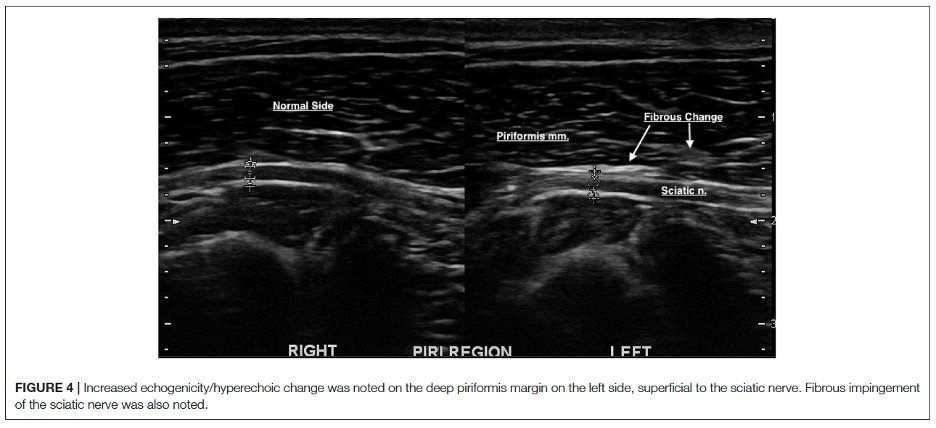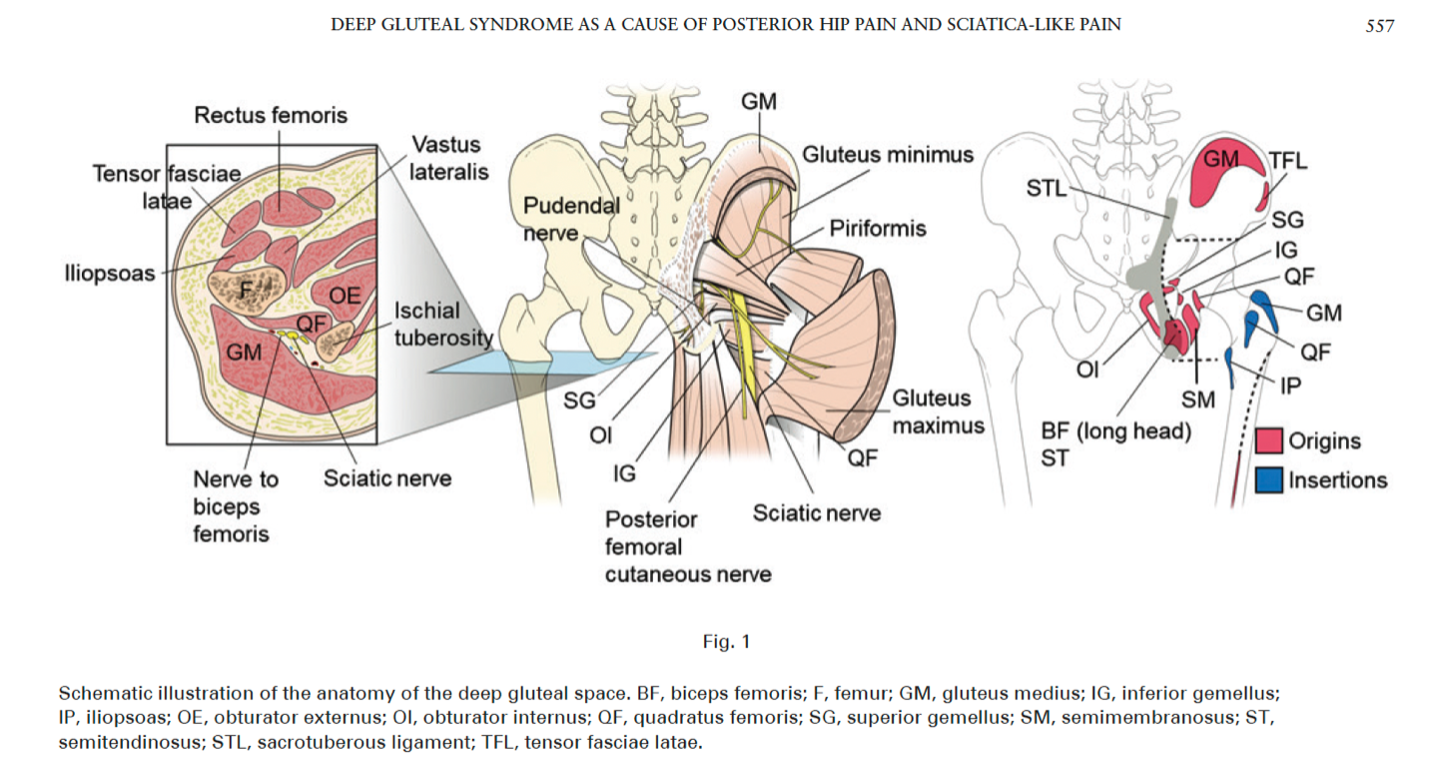Laurie's Blogs.
Aug 2023
Piriformis Syndrome in Dogs… and the can of worms it opens up!
There is one paper that discussed piriformis syndrome in dogs. Rather, it discusses findings in 29 dogs with suspected sciatic neuritis.1
It was a retrospective study of cases that received diagnostic ultrasound over the gluteal region in a 2-year period at a veterinary specialist centre. 26 dogs had a gait evaluation, and all had an orthopaedic exam.
Palpation Findings
“Most of the dogs had multiple abnormal palpation findings within the lumbar and/or hind limbs of the affected sciatic nerve: 22/29 dogs (76%) had pain, spasm, or trigger points in the iliopsoas muscle; 10/29 (35%) showed restriction or pain on hip extension. One of these dogs also experienced pain during hip flexion; 9/29 (31%) had pain or tenderness on palpation of the lumbosacral area; 14/29 (48%) presented with pain on direct palpation of the gluteal/sciatic area or restriction on the piriformis stretch. Nineteen 19/29 dogs (66%) also presented with abnormal findings on the stifle. Findings included effusion and/or pain on extension or flexion of the stifle or luxating patella; 4/29 (14%) had rotation or malalignment at the sacroiliac (SI) joint, and one 1/29 dog (3%) had effusion on the tarsal joint. Most of the dogs had abnormal findings in multiple anatomical areas of the affected limb. One dog exhibited abnormal palpation in the gluteal area without any other abnormal clinical findings.”

From Toijala et al, 2021.
Here's the thing… I am hearing more and more about dogs being diagnosed with piriformis syndrome and being treated with phonophoresis for the issue. Okay, so let’s unwrap this!
Firstly, since there is a dearth of information on the veterinary side, let’s go human. I searched for systematic reviews about piriformis syndrome.

- Piriformis syndrome can be defined by a quartet of symptoms and signs: buttock pain, pain aggravated on sitting, external tenderness near the greater sciatic notch and pain on any maneuver that increases piriformis muscle tension, and limitation of straight leg raising.2
- The typical morphological pattern (type A, with the sciatic nerve (SN) passing undivided below the piriformis muscle) was found to be the most common variant, with 90% pooled prevalence. SN variants were more common among East Asians, with a 31% pooled prevalence of total variants. No significant differences were established with respect to gender and laterality. In greater than 10% of the population, the SN coursed through or above piriformis.3
- Deep gluteal syndrome (DGS) is a recognized disease entity, caused by compression of the sciatic or pudendal nerve due to non-discogenic pelvic lesions. It includes the piriformis syndrome, the gemelli-obturator internus syndrome, the ischiofemoral impingement syndrome, and the proximal hamstring syndrome. The concept of the deep gluteal syndrome extends our understanding of posterior hip pain due to nerve entrapment beyond the traditional model of the piriformis syndrome.4
- The general diagnostic pathway for DGS was composed of history taking (posterior hip pain, radicular pain, and difficulty sitting for 30 min), physical examination (tenderness in deep gluteal space, positive seated piriformis test, and positive Pace sign), and imaging tests (pelvic radiographs, pelvic MRI, and spine MRI).5
So, firstly the findings of the canine retrospective study cannot lay claim that the sciatic nerve inflammation or evidence of sciatic impingement was the source of any lameness or clinical findings. It is merely one piece of the puzzle. To be honest, my first thought isn’t ‘how to fix the piriformis syndrome’ (assuming it exists) but rather, what all could cause (and be at the root of) the sciatic nerve impingement. I find intriguing the findings of a 1999 paper by Fortin et al: Studies have also shown that sciatic pain (in patients clear of lumbar disc or stenotic issues) may arise from the extravasation of sacroiliac joint fluid near the lumbosacral plexus or the presence of Substance P in the periarticular tissues of the SIJ.6

TREATMENT
Prior to considering surgical or injectable solutions for the treatment of piriformis syndrome (or deep gluteal syndrome) in people, is done via physical therapies. I was able to find papers describing positional release techniques and muscle energy techniques designed to create an inhibition of the piriformis muscle.7 Another paper highlighted treating the condition via strengthening of the hip abductors and external rotator muscles.8
A review paper concluded that “after studying various articles about the different approaches for the management of piriformis syndrome, stretching on a regular basis has been shown to be quite effective for this condition and for improving the functional activity of hip articulation. Neural mobilization has been found to be one of the primary interventions for symptomatic relief. It reduces the irritation of the sciatic nerve occurring due to the spasm of piriformis muscle. Although this technique provides a transitory relief, when combined with muscle stretch, it gives a better and faster outcome.”9
What I did not find were any reference to (or successes with) photobiomodulation, therapeutic ultrasound, or phonophoresis.
Where does this leave us?
I’m thinking that the diagnosis of piriformis syndrome in dogs needs further investigation to say whether it exists or not. (It is a questionable diagnosis in human medicine to begin with!)10 Furthermore, if one was going to treat this presumed diagnosis, phonophoresis would not have the support from available literature sources to warrant it as a line of treatment.
Until next time… Cheers!
Laurie
References:
- Toijala TM, Canapp DA, Canapp SO. Ultrasonography Findings in the Proximal Sciatic Nerve and Deep Gluteal Muscles in 29 Dogs With Suspected Sciatic Neuritis. Front Vet Sci. 2021 Aug 27;8:704904.
- Hopayian K, Danielyan A. Four symptoms define the piriformis syndrome: an updated systematic review of its clinical features. Eur J Orthop Surg Traumatol. 2018 Feb;28(2):155-164.
- Poutoglidou F, Piagkou M, Totlis T, Tzika M, Natsis K. Sciatic Nerve Variants and the Piriformis Muscle: A Systematic Review and Meta-Analysis. Cureus. 2020 Nov 17;12(11):e11531.
- Park JW, Lee YK, Lee YJ, Shin S, Kang Y, Koo KH. Deep gluteal syndrome as a cause of posterior hip pain and sciatica-like pain. Bone Joint J. 2020 May;102-B(5):556-567.
- Kizaki K, Uchida S, Shanmugaraj A, Aquino CC, Duong A, Simunovic N, Martin HD, Ayeni OR. Deep gluteal syndrome is defined as a non-discogenic sciatic nerve disorder with entrapment in the deep gluteal space: a systematic review. Knee Surg Sports Traumatol Arthrosc. 2020 Oct;28(10):3354-3364.
- Fortin JD, Kissling RO, O’Connor BL, Vilensky JA: Sacroiliac Joint Innervation and Pain. Am J Orthop. Dec: pp 687 -690, 1999.
- Danazumi MS, Yakasai AM, Ibrahim AA, Shehu UT, Ibrahim SU. Effect of integrated neuromuscular inhibition technique compared with positional release technique in the management of piriformis syndrome. J Osteopath Med. 2021 May 31;121(8):693-703.
- Tonley JC, Yun SM, Kochevar RJ, Dye JA, Farrokhi S, Powers CM. Treatment of an individual with piriformis syndrome focusing on hip muscle strengthening and movement reeducation: a case report. J Orthop Sports Phys Ther. 2010 Feb;40(2):103-11.
- Ahmad Siraj S, Dadgal R. Physiotherapy for Piriformis Syndrome Using Sciatic Nerve Mobilization and Piriformis Release. Cureus. 2022 Dec 26;14(12):e32952.
- Sharma S, Kaur H, Verma N, Adhya B. Looking beyond Piriformis Syndrome: Is It Really the Piriformis? Hip Pelvis. 2023 Mar;35(1):1-5.


